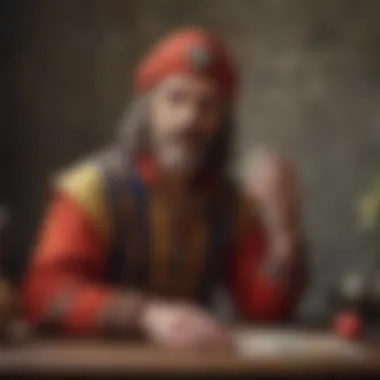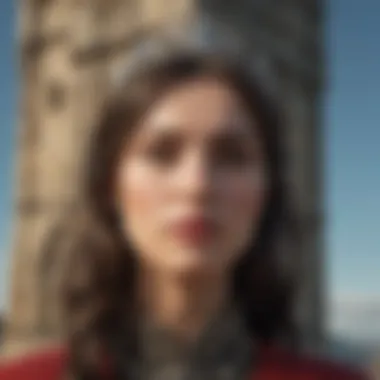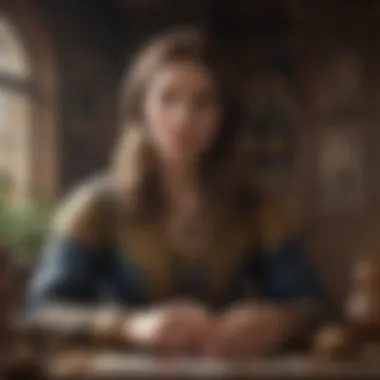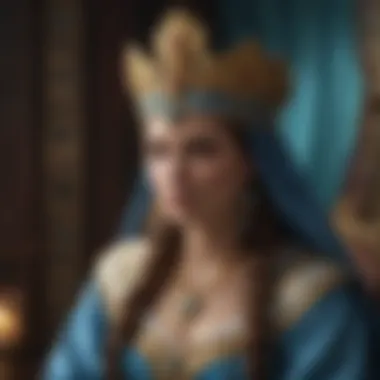Unveiling the Major Arcana in Rider-Waite-Smith Tarot


Intro
The Major Arcana of the Rider-Waite-Smith Tarot holds a prominent place in the study of tarot. Each card in this section serves as a key that opens doors to deeper understanding and insights. The significance of these cards extends far beyond mere divination; they encompass profound themes of personal development and existential reflection. This section will shed light on how the Major Arcana can guide individuals through life’s uncertainties and decision-making processes.
Understanding Major Arcana
Overview of Major Arcana Cards
The Major Arcana comprises 22 cards, numbered from 0 to 21. Each card represents distinct archetypes and universal themes, including The Fool, The Magician, and The World. These cards encapsulate the journey of self-discovery and personal evolution. Traditionally, the emphasis on Major Arcana suggests critical events or lessons in a person’s life.
Symbolism and Interpretations
The imagery in each Major Arcana card is rich with meaning. For example, The Fool symbolizes new beginnings and spontaneity, while The Lovers reflects choices around relationships. Understanding the symbols helps readers decode the messages pertinent to their lives. Thus, taking time to contemplate the unique aspects of each card can yield insight relevant to personal circumstances.
The Major Arcana describes key spiritual lessons and life transitions, making them vital in readings for any serious practitioner.
Historical Context
Understanding the historical background of the Rider-Waite-Smith Tarot enhances appreciation for the Major Arcana. Developed in the early 20th century by Arthur Edward Waite and illustrated by Pamela Colman Smith, the deck was innovative in its approach. Unlike earlier tarot decks, it depicted scenes filled with symbolism. It solidifies the Major Arcana as a bridge between esoteric wisdom and practical guidance.
The Impact of the Deck
Rider-Waite-Smith Tarot has had an enduring impact on the tarot landscape. Its influence can be seen in various modern interpretations and adaptations of tarot. The way Major Arcana cards are positioned within readings reflects the significance of life paths that people navigate. This context becomes essential when interpreting not just the cards but also the reader's intention and aspirations.
Practical Applications
Harnessing the strengths of the Major Arcana leads to profound personal growth and self-awareness. Readers can utilize these cards to clarify thoughts and feelings. Engaging with the Major Arcana may enhance one's understanding of fate, circumstances, and choices available in life.
Self-Reflection and Decision-Making
Focusing on Major Arcana cards can promote self-reflection. A reader may draw a card to prompt contemplation about current life paths or decisions that require clarity. This practice not only informs one about the present but also encourages a deeper examination of future possibilities.
Integration in Daily Life
Incorporating Major Arcana insights into daily routines encourages personal growth. Setting intentions with the guidance of a card can align daily actions with larger life goals. It fosters empowerment and enhances one’s ability to make informed choices.
Closure
The Major Arcana in the Rider-Waite-Smith Tarot serves not merely as a tool for divination, but as a roadmap for personal discovery. By delving into the intricate details of the cards, we unravel the complex relationship between symbolism, history, and personal insight in the quest for understanding both self and fate.
Preamble to Rider-Waite-Smith Tarot
The Rider-Waite-Smith Tarot is a cornerstone in the realm of tarot reading. It embodies a rich blend of symbolism, artistry, and storytelling that has captivated both novices and experienced practitioners alike. Understanding its significance is crucial for anyone wishing to delve into the art of tarot. This section elucidates the foundational aspects of the Rider-Waite-Smith Tarot, preparing readers for a deeper exploration of the Major Arcana that follows.
Historical Background
The Rider-Waite-Smith Tarot emerged in the early 20th century, a product of various cultures and mystical traditions that laid the groundwork for modern tarot. The deck was created by artist Pamela Colman Smith and Arthur Edward Waite, both prominent figures in the esoteric movements of their time. Their collaboration resulted in a deck that combined rich imagery with profound meaning, making it more accessible to the public.
According to historical records, the deck was first published in 1909 by William Rider and Son in England. It quickly gained popularity and became one of the most widely used tarot decks around the world. The art, which features detailed illustrations for all cards, was revolutionary. It shifted away from older decks that used mainly symbols and minimal artwork, thus giving the user a more intuitive grasp of the tarot’s meanings.
Tarot historians emphasize the importance of understanding this historical context. The historical significance adds layers to the imagery and meanings present in the Major Arcana. For instance, the cultural undertones in the cards often reflect the societal norms and beliefs of the time, providing insights into the evolution of tarot as a tool for self-reflection and divination.
Notable Figures Involved


Within the creation of the Rider-Waite-Smith Tarot, key figures played pivotal roles in its development. Arthur Edward Waite was a scholar and a member of the Hermetic Order of the Golden Dawn, a society that contributed significantly to the study of the occult. His ideas and interpretations influenced the thematic structures observed in the deck.
Pamela Colman Smith, the artist behind the illustrations, brought a distinct visual language to the cards. She was known for her theatrical art and her deep understanding of symbolism, which is evident in every card she illustrated. Although her contributions were not fully recognized during her lifetime, today, she is celebrated for her innovative designs that transformed the way tarot is perceived.
These figures not only shaped the Rider-Waite-Smith Tarot but also left an indelible mark on the field of tarot as a whole. Their collaborative efforts have led to a deck that remains relevant, encouraging ongoing exploration and study in various cultural and spiritual contexts.
“The Rider-Waite-Smith Tarot profoundly influences how tarot is understood and applied today.”
Recognizing their contributions is crucial for tarot readers, as it provides a deeper appreciation for the cards and enhances interpretation skills.
Understanding the Structure of the Deck
The structure of the Rider-Waite-Smith Tarot deck is crucial for grasping its depth and significance. This understanding lays the foundation for effective readings and personal insights. Comprehending how the Major and Minor Arcana interact can enhance the intuitive connection a reader has with the cards.
The Tarot deck consists of 78 cards, which are divided into two primary sections: the Major Arcana and the Minor Arcana. Each section holds unique meanings and contributes differently to the overall reading. The Major Arcana cards symbolize major life events and spiritual lessons, while the Minor Arcana typically represent day-to-day experiences and the nuances of daily life.
This structural understanding allows tarot readers to interpret the cards in a more meaningful way. By acknowledging the relationship between the two, readers can identify when a reading might address profound life changes or simply offer insight into more routine matters. Here, it is essential to appreciate how each card within both the Major and Minor Arcana tells a part of a larger story, aiding in a holistic understanding of the querent's journey.
Major Arcana Overview
The Major Arcana serves as the heart of the Rider-Waite-Smith Tarot. It includes 22 cards, each carrying significant symbolism and archetypal themes that reflect fundamental aspects of human experience. The journey through the Major Arcana is often seen as a path of personal evolution, depicting a narrative from the innocence of The Fool to the completion symbolized by The World.
The Major Arcana cards are distinct not only for their meanings but also for their overarching purpose in tarot readings. They often signal critical turning points or deep dives into the psyche. The presence of these cards in a spread can intensify the reading, indicating powerful forces at play in a querent's life. Understanding these symbols is essential for interpreting insights and gaining clarity on personal growth, challenges, and opportunities.
Minor Arcana Explanation
The Minor Arcana, comprising 56 cards, is divided into four suits: Cups, Pentacles, Swords, and Wands. Each suit symbolizes different spheres of life, influencing the context of the readings. For example, Cups often relate to emotional matters and relationships, while Pentacles touch on elements of material well-being and career.
Unlike the Major Arcana, which highlights major themes and lessons, the Minor Arcana addresses everyday situations and decisions. These cards reflect the more routine and sometimes mundane aspects of life. However, they are equally important in a reading, providing context and depth to the messages conveyed by the Major Arcana.
The Major Arcana: Symbolism and Interpretation
The Major Arcana is a vital component of the Rider-Waite-Smith Tarot. This section aims to dissect the layers of symbolism embedded within each card and its interpretation. The arcana serve as a profound reflection of the human experience, encapsulating themes of growth, introspection, and understanding the cosmic forces at play. By engaging deeply with the symbolism, tarot readers can unlock meaningful insights that aid in personal and collective journeys.
The Fool
The Fool is often regarded as the beginning of the journey in the Major Arcana. Represented by a youthful figure, this card symbolizes potential and new beginnings. The Fool embodies spontaneity, exploration, and the excitement of embarking on an unknown path.
In readings, The Fool can signal an invitation to embrace change and take risks. It urges individuals to trust their instincts and look beyond traditional boundaries. The imagery, such as the white dog at their feet, represents loyalty and instinct, reminding us to remain grounded despite new adventures.
The Magician
The Magician symbolizes mastery and resourcefulness. This card illustrates the ability to channel energies and utilize skills effectively. Here, every element—earth, water, air, and fire—comes together, showcasing the connection between the material and spiritual realms.
In a reading, The Magician encourages self-confidence and active participation in one’s destiny. It invites the querent to harness their talents and essential tools. The Magician asks us to manifest our desires and be proactive in our endeavors.
The High Priestess
The High Priestess stands as a guardian of intuitive knowledge and inner wisdom. This card represents feminine energy, mystery, and the subconscious. The veil behind her hints at the hidden truths that require patience and discernment to uncover.
This card prompts introspection and meditation. When The High Priestess appears, it encourages the seeker to trust their intuition and seek knowledge from within. It often signifies times to listen to one's instincts and reflect on deeper emotions.
The Empress


The Empress embodies abundance, fertility, and nurturing. This card symbolizes the connection to nature and the importance of creating and fostering life. The lush surroundings in her imagery signify growth and harmony.
In readings, The Empress represents a phase of creativity and nurturing relationships. It can indicate a time for cultivating ideas and projects or signify the people in one’s life who provide warmth and support. Overall, it emphasizes the significance of embracing a caring attitude towards oneself and others.
The Emperor
The Emperor represents authority, structure, and control. This card embodies masculine energy, enforcing rules and establishing order in one’s life. The Emperor's presence in a reading often signals the need for stability and discipline, suggesting a time to assert boundaries or take charge of circumstances.
The Emperor encourages leadership and responsibility. He reminds us that a firm foundation is necessary for growth. When this card appears, it can advocate for making decisions that enhance structure and reliability in various aspects of life.
Other Major Arcana Cards
The remaining cards of the Major Arcana expand the themes of life’s cycle, reflecting experiences like judgment, transformation, and the pursuit of spiritual enlightenment. Cards such as The Lovers contend with choices and dualities. The Chariot encapsulates determination and overcoming obstacles.
Each Major Arcana card serves as a reflection of essential life lessons, offering insights that can aid in personal growth and the understanding of one's path.
This depth of symbolism reveals an intricate web of meanings, prompting deeper contemplation and understanding. In sum, the Major Arcana is not just a collection of images; it is a powerful tool for insight and understanding, guiding users through the complexities of life.
Lessons from the Major Arcana
The Major Arcana holds much significance in tarot, especially in the Rider-Waite-Smith deck. These twenty-two cards represent fundamental experiences and lessons one encounters in life. Within this section, we will delve into two main aspects: personal growth insights and decision-making guidance. By understanding these lessons, readers can gain deeper insights into themselves and their life path.
Personal Growth Insights
Personal growth is often a crucial aspect for those who seek guidance from the tarot. The Major Arcana cards symbolize various stages of life, encompassing the gamut of human experience. Each card functions as a mirror, reflecting desires, fears, and potential paths for the seeker.
- The Fool initiates a journey, representing new beginnings. It suggests that embracing uncertainty can lead to transformative experiences.
- The High Priestess encourages introspection and intuition. This card reminds us that inner wisdom is key to navigating challenges.
- The Empress and The Emperor highlight the balance between nurturing and authority in personal development. They illustrate how harmony in relationships can foster growth.
Rider-Waite-Smith in Contemporary Tarot Practices
The Rider-Waite-Smith tarot deck holds a significant place in modern tarot practices. Its imagery, symbolism, and meanings are deeply ingrained in contemporary readings and discussions about tarot. This deck has not only shaped the understanding of tarot but also continues to influence the way people approach tarot reading today. By dissecting its role in current practices, we can illuminate how it serves as a tool for introspection, guidance, and connection to broader spiritual themes.
Popularity and Influence
The Rider-Waite-Smith tarot deck is perhaps the most popular tarot deck in existence. Its imagery and symbolism are easily recognizable. Many readers, regardless of their level of expertise, gravitate toward this deck because of its clear visuals and straightforward interpretations. The widespread availability of this deck has contributed to its influence, making it a staple in both personal readings and public workshops.
The deck has helped to demystify tarot. Some individuals view tarot as an esoteric system, while others see it as a psychological tool. The Rider-Waite-Smith deck transcends these perspectives. Its cards offer insights into personal struggles, relationships, and decision-making processes. Furthermore, the accessible artwork can resonate with a diverse range of individuals, making tarot inclusive.
The Rider-Waite-Smith tarot deck bridges the gap between the mystical and the practical, allowing for both spiritual exploration and personal reflection.
Adaptations and Variations
In recent years, numerous variations of the Rider-Waite-Smith deck have emerged. These adaptations often reflect cultural changes or address specific themes. For instance, there are decks tailored to feminist perspectives, multicultural illustrations, or even those that cater to specific spiritual beliefs. These variations honor the original deck while innovating on its concepts.
Such adaptations show the versatility of the Rider-Waite-Smith system. Different artists bring their interpretations, yet the fundamental symbolism remains intact. This connection to the original deck allows newer readers to ground their understanding in established meanings while exploring novel interpretations. The synergy of the original and its adaptations enriches the overall tarot community.
In the context of contemporary practices, these variations pave the way for new dialogues around tarot readings. Readers now have the luxury to choose decks that resonate deeply with their identities or aspirations. This personalization enhances the relevance of tarot in today’s spiritual landscape, fostering deeper connections between the cards and the user's experiences.
Overall, the Rider-Waite-Smith deck remains a crucial element in the evolving world of tarot, showcasing its extraordinary ability to adapt while retaining its integral components.
How to Use the Rider-Waite-Smith Deck
The Rider-Waite-Smith tarot deck has gained prominence for its rich symbolism and intricate designs. Learning how to use this deck goes beyond mere card reading; it encompasses understanding the meanings, connections, and practical applications of its cards. Mastering this deck can greatly enhance one's journey into tarot, revealing personal insights and transformative experiences.


Basic Spreads
Understanding basic spreads is an initial step for anyone interested in reading the tarot. Common spreads provide organization and clarity for interpreting the cards. Here are some essential spreads to consider:
- One-Card Pull: This simple spread is useful for daily guidance or quick insights. It allows for focusing on a specific question or theme.
- Three-Card Spread: Typically used to explore past, present, and future. This offers a deeper narrative and context around a particular query.
- Celtic Cross: A more complex spread. It provides comprehensive views on situations, revealing internal and external influences, challenges, and potential outcomes.
Each of these spreads serves a unique purpose, allowing for various levels of depth in readings. Understanding these structures is crucial for beginners and experts alike, fostering more meaningful interpretations of the cards.
Intuitive Reading Techniques
Intuitive reading approaches enable readers to connect with the tarot on a more personal level. Here are some techniques that enhance the reading experience:
- Meditation with Cards: Spend time with a specific card to understand its message. This process allows deeper connections with the individual symbolism.
- Journaling: Documenting card pulls can uncover patterns, themes, and personal insights over time. It’s a great way to track growth and understanding.
- Personal Associations: Each reader may connect different meanings or feelings to certain cards. Trusting one’s instincts is valuable for authentic interpretations.
Utilizing these techniques can make readings more impactful, as they invite a unique perspective into the practice.
Exploring the Rider-Waite-Smith tarot deck is not just an academic pursuit; it is a journey toward self-discovery and personal insight.
In summary, using the Rider-Waite-Smith deck effectively involves understanding basic spreads and employing intuitive techniques. Together, these elements form a foundation for enriching tarot experiences, facilitating personal growth and deeper insights.
Cultural and Spiritual Context of Tarot
The cultural and spiritual context of tarot holds significant weight when exploring the Rider-Waite-Smith deck, particularly its Major Arcana. Understanding this context enriches the reader's appreciation and interpretation of the cards. Tarot does not solely serve as a tool for divination; it is a reflection of various cultural and spiritual traditions. This framework provides insights that evolve with each generation and cultural environment.
Emergence of Tarot in Spiritual Practices
Tarot's emergence as a spiritual tool is multi-layered and complex. It began in the 15th century, used primarily for playing games. However, by the 18th century, tarot began to intertwine with spirituality and mysticism. Figures like Antoine Court de Gébelin promoted tarot as an ancient Egyptian wisdom system, claiming that the cards held esoteric secrets.
As the interest in the occult grew during the late 19th and early 20th centuries, tarot cards became a focal point in spiritual circles, seen as gateways to deeper understanding. The Rider-Waite-Smith deck, released in 1909, reflected this renewed interest, integrating rich symbolism meant to connect the reader to the spiritual realm. This symbolism, especially within the Major Arcana, encourages introspection and self-discovery.
Tarot and Astrology Connections
The relationship between tarot and astrology is profound and multifaceted. Each Major Arcana card corresponds to specific astrological attributes and archetypes. This connection implies a relationship between celestial movements and personal experiences. For instance, the Fool can be linked to Uranus, symbolizing individualism and new beginnings.
Moreover, tarot readers often incorporate astrological insights into their readings to enhance understanding. Aligning tarot cards with astrological signs provides layers of meaning. This method encourages users to contemplate timing and cosmic influence in their lives.
In a world that increasingly seeks spiritual and conceptual frameworks, the cultural and spiritual context of tarot contributes to its depth. By recognizing tarot's origins in both spiritual practices and its connections to astrology, readers can draw valuable insights from the Major Arcana, elevating their understanding and practical usage.
Tarot serves as a bridge between the human experience and the greater cosmos, revealing the interconnectedness of life.
Understanding these themes can significantly enhance the experience of those who engage with the Rider-Waite-Smith tarot deck. As such, it invites deeper reflection on personal and collective journeys.
End
The conclusion of this article emphasizes the significance of understanding the Major Arcana within the context of the Rider-Waite-Smith tarot deck. This section serves to synthesize the insights gained throughout the previous discussions. By highlighting both the symbolic richness and practical applications of the Major Arcana, readers are encouraged to reflect on how these cards can influence their personal and spiritual journeys.
Recap of Major Insights
The Major Arcana consists of 22 cards, each one representing profound themes such as change, growth, and enlightenment. The unique journey through these cards reflects the human experience, offering insights at various levels. Key takeaways include:
- Symbolism: Each card in the Major Arcana holds a wealth of symbols that can deepen understanding.
- Interpretation: Understanding individual cards requires an appreciation of their narrative and context within the larger reading.
- Personal Growth: The lessons derived from the Major Arcana are critical for personal development.
These points underline the importance of not just seeing the cards as mere tools for fortune-telling but as instruments for introspection and understanding one’s path in life.
Implications for Future Readers
For those stepping into the world of tarot reading, grasping the essence of the Major Arcana is crucial. The implications of this study extend beyond mere academic interest. They can enhance the practitioner's understanding, promote informed decision-making, and aid in personal exploration. Future readers should consider the following aspects:
- Integration: Combining knowledge of Major Arcana with personal intuition will lead to more meaningful readings.
- Continuous Learning: As insights evolve with experience, continuous study and practice are paramount.
- Community Engagement: Engaging with fellow readers, through platforms like Reddit or specialized groups on Facebook, can broaden perspectives and deepen understanding.
By recognizing the depth and significance of the Major Arcana in the Rider-Waite-Smith tarot deck, readers can enhance their divination skills and deepen their insight into the human condition.







